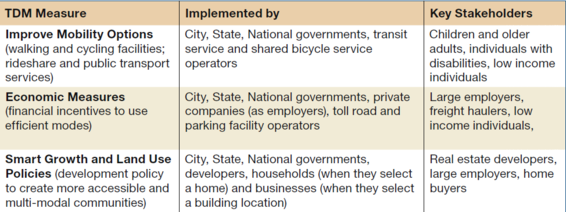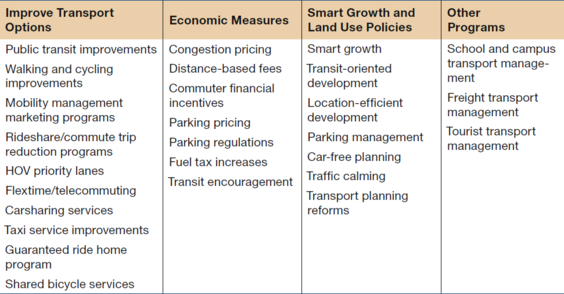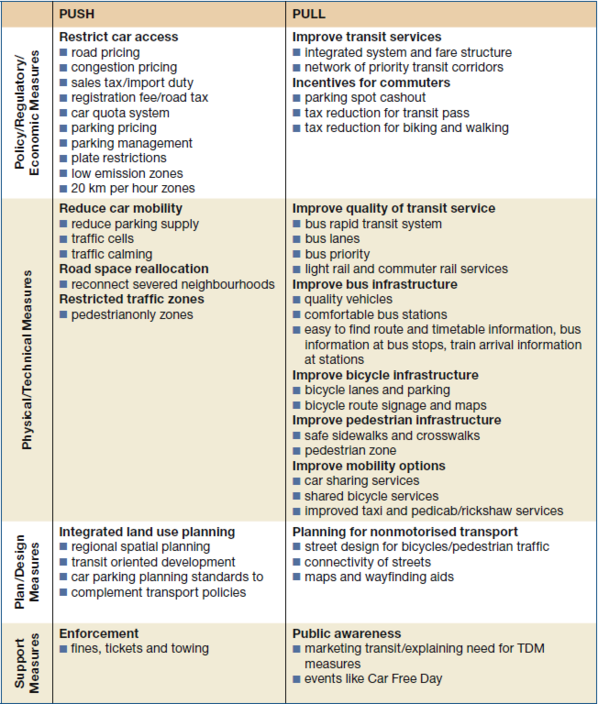Difference between revisions of "Transportation Demand Management"
***** (***** | *****) |
***** (***** | *****) m |
||
| Line 103: | Line 103: | ||
= Further Information = | = Further Information = | ||
| − | Further and more detailed information can be found on the homepage of the [http://www.sutp.org/ Sustainable Urban Transport Project]. The Sustainable Urban Transport Project aims to help developing world cities achieve their sustainable transport goals, through the dissemination of information about international experience, policy advice, training and capacity building. | + | *Further and more detailed information can be found on the homepage of the [http://www.sutp.org/ Sustainable Urban Transport Project]. The Sustainable Urban Transport Project aims to help developing world cities achieve their sustainable transport goals, through the dissemination of information about international experience, policy advice, training and capacity building. |
| + | *[[Portal:Mobility|Portal:Mobility]]<br/> | ||
| + | *[[Adapting_Urban_Transport_to_Climate_Change|Adapting Urban Transport to Climate Change]]<br/> | ||
| + | *[[Assessing_Climate_Finance_for_Sustainable_Transport|Assessing Climate Finance for Sustainable Transport]]<br/> | ||
<br/> | <br/> | ||
| Line 113: | Line 116: | ||
<references /> | <references /> | ||
| + | [[Category:Transport]] | ||
[[Category:Mobility]] | [[Category:Mobility]] | ||
| − | |||
Revision as of 10:07, 11 July 2014
Challenging Traffic Growth in Developing Countries
This article has been adapted from the GIZ Sourcebook on Transportation Demand Management. [1]
Impacts of Car-oriented Development
Rapid and unconstrained growth of private vehicle use in developing cities has real and significant consequences for cities and the people living in them. Environmental impacts such as degraded air and water quality soon translate into human impacts such as asthma and premature mortality. Although many of these problems are already experienced by developed country cities, many rapidly developing cities are repeating – or are pose to repeat – the same mistakes. Transportation Demand Management (TDM) measures offer an opportunity to avoid the costly and flawed path of car domination that developed country cities are now try to recover from.
The impacts of increasing motorization include:
- Air quality: Vehicle emissions harm human health and the natural environment
- Noise and vibration: Noise affects productivity and health
- Accidents: Each year 1.2 million lives are lost due to vehicle accidents
- Global Climate Change: vehicles are responsible for roughly 25% of fossil-based CO2 emissions
- Natural habitats: Roadways disrupt habitats and open areas to exploitation
- Waste disposal: the disposal of vehicles and vehicle parts contribute to landfill problems
- Congestion: Time lost in congestion affects overall productivity
- Energy Security: Dependence on petrol-based mobility affects national security
- Economic efficiency: Financial capital consumed by car expenditures reduces capital for other investments
Leapfrogging with TDM
Developing country cities are well positioned to skip over, or “leapfrog” an era of car-dominated development and its expensive impacts. The first step is to re-orient transportation policy, planning, and engineering around the goal of improving access for people and goods. Then a set of TDM measures which both push and pull drivers out of their vehicles should be implemented.
Developing a Comprehensive Transportation Deman Management Strategy
Defining Transportation Demand Management (TDM)
Transportation Demand Management (TDM) is a strategy which aims to maximize the efficiency of the urban transport system by discouraging unnecessary private vehicle use and promoting more effective, healthy and environmental-friendly modes of transport, in general being public transport and non-motorised transport. TDM can also be described as a set of measures to influence traveller behaviour in order to reduce or redistribute travel demand. Demand for transportation follows the general economic theory of supply and demand
Principles of Efficient Pricing
Pricing can be an effective way to address transportation problems and increase transportation system efficiency, but to be effective, prices must reflect the following principles:
Consumer options: Consumers must have viable options from which to choose, so they can select the combination of quantity, quality and price that best meets their needs. For example, implementing road or parking pricing in a corridor may have little effect on traffic volumes if travellers have no viable alternatives such as high quality public transport serving that corridor.
Cost-based prices: To be efficient, prices should reflect the incremental costs of producing that good, including direct and indirect costs of production, distribution and disposal.
Economic neutrality: This means that public policies treat comparable goods equally, unless there is a specific justification for special treatment. Efficient pricing gives consumers incentives to choose the most efficient options for each trip. For example, congestion pricing (road tolls that are highest during congested periods) give travellers an incentive to change when and how they travel to avoid peak-period automobile trips when they can.
Forces Driving Transport Demand
In order to evaluate TDM measures it is useful to consider various factors that affect travel demand and therefore influence travel behaviour. These factors include:
- Household wealth and vehicle ownership
- Road and parking facility supply and quality
- Prices (for fuel, road use, parking, transit fares)
- The relative speed, convenience and comfort of travel by private vehicle and public transport
- Walking and cycling conditions
- Land use patterns (the distributions of destinations)
- Traveller habits and expectations
Types of TDM Measures
TDM increases transport efficiency by providing various incentives for individuals to change their travel time, route, mode, destination, frequency, and cost.
TDM focuses on access to services and activities, rather than vehicle traffic. For example, if road or parking facility is congested at certain times, rather than expanding roads and parking facilities, TDM may encourage some people to shift from peak to off-peak periods, to travel by alternative modes (walking, cycling, ridesharing, public transport), to choose alternative destinations, or to park offsite at another parking lot.
Because TDM measures seek to influence behaviour they may involve a variety of stakeholders, not just transportation agencies.
Developing a Comprehensive TDM Strategy
Most TDM measures have modest individual impacts, typically affecting a few per cent of total vehicle travel in an area. In order to achieve significant total impacts it is usually necessary to develop a comprehensive TDM strategy that includes an appropriate set of measures. A comprehensive TDM strategy can have synergistic effects, that is, its total impacts are greater than the sum of TDM measures implemented individually.
For maximum effectiveness and benefits, a comprehensive TDM strategy needs both positive (“pull”) incentives, such as improved travel options, and negative (“push”) incentives, such as road and parking fees.
Just as supply-side transportation measures are implemented at a mixture of approaches and scales, so demand-side measures should be.
A comprehensive TDM strategy for a city requires a mix of the three types of TDM measures:
- Improve mobility options
- Economic measures
- Smart growth and land use policies
A comprehensive TDM strategy is like a three legged stool – it will not stand up without all three legs, because they all reinforce each other.
A three-pronged comprehensive TDM strategy approach requires support from the various institutions responsible for implementing TDM measures. This means that the stakeholders need to be informed, motivated, and engaged. Supportive measures implemented by law enforcement and by private-sector stakeholders also play an important legitimizing role.
Further Information
- Further and more detailed information can be found on the homepage of the Sustainable Urban Transport Project. The Sustainable Urban Transport Project aims to help developing world cities achieve their sustainable transport goals, through the dissemination of information about international experience, policy advice, training and capacity building.
- Portal:Mobility
- Adapting Urban Transport to Climate Change
- Assessing Climate Finance for Sustainable Transport
References
- ↑ A. Broaddus, T. Litman, G. Menon 2009, Transportation Demand Management, Eschborn, Germany






















